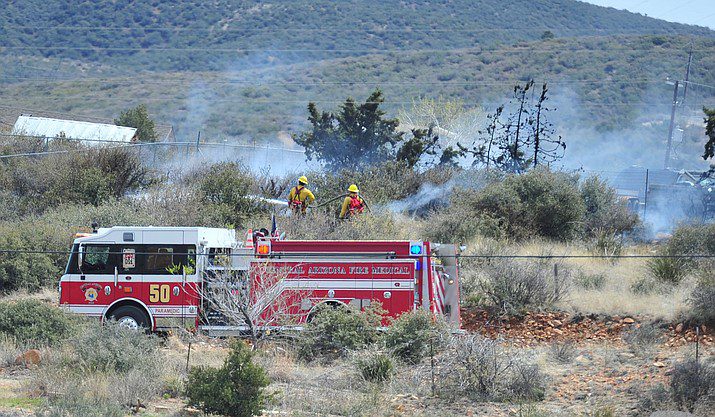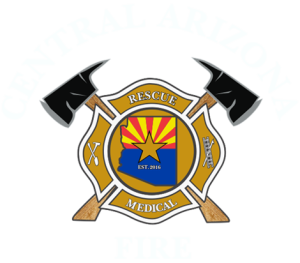Home » Departments » United States » Arizona » Prescott Valley » Central Arizona Fire and Medical Authority
Overview
Central Arizona Fire and Medical Authority (CAFMA) Operations is responsible for fire suppression, emergency medical services, wildland response, training, and special operations activities within our 369 square mile area covering Prescott Valley, Chino Valley, Dewey-Humboldt and unincorporated areas of Yavapai County. Operations personnel respond to over 16,000 calls each year out of 10 full-time stations, two reserve stations, and a 40-hour engine that operates out of our Training Center.
Operations is comprised of full-time personnel organized into three shifts in two battalions, Battalion 3 and Battalion 6. Each is supervised by a Battalion Chief who is responsible for emergency and administrative functions for their particular shift and battalion. Each Battalion Chief subsequently reports directly to the Assistant Chief of Operations. The work schedule is an alternating schedule of 24-hour shifts.(3-4)
Our agency takes part in automatic aid, countywide, and statewide mutual aid. CAFMA response to fire and medical emergencies immediately outside the Authority’s jurisdiction will be limited to those areas which are protected by contract or by an agency which has a current automatic/mutual aid or intergovernmental agreement with the CAFMA. CAFMA resources may respond to automotive accidents within a five (5) mile area beyond our geographical boundaries.
In addition to firefighting and medical training, CAFMA employs personnel that are trained and equipped to handle unusual or technically challenging calls that fall outside normal fire or emergency medical responses. The personnel making up these special units, or teams, are fire authority personnel that have been trained to confront incidents that pose a high degree of risk to both community members and responders.
Special Operations
Within our Operations Division, there is a team of personnel that are specially trained to handle highly technical responses. The members of the teams are local, as well as regional assets as members of the Prescott Regional Technical Rescue Team and the Prescott Area Hazardous Materials Team.
In addition, our Wildland Division consists of highly trained personnel that respond in our area, around the State of Arizona as well as to other States. We are proud to employ members of both Type I and Type III incident management teams specializing in wildland and All Hazard incident response.
Fire Departement
Sorry, no records were found. Please adjust your search criteria and try again.
Sorry, unable to load the Maps API.
Contact Information
, Arizona





Rating Breakdown
1/5
2.3/5
3.3/5
2.7/5
3 Reviews on “Central Arizona Fire and Medical Authority”
Leadership & Administration
Leadership under the former fire chief was defined by a top-down, authoritarian style that deeply fractured the relationship between administration and frontline personnel. He remained largely disconnected from daily operations, focusing instead on self-promotion through public speaking engagements and costly conferences that offered little tangible benefit to the agency. Concerns raised by line-level staff—particularly regarding operational issues like the 48/96 shift schedule—were met with indifference or outright dismissal. Employees who voiced differing opinions or advocated for change were frequently marginalized. This rigid, retaliatory leadership approach stifled open dialogue, eroded morale, and created a workplace climate defined by fear of retribution.
Administrative processes during this time were similarly flawed, particularly in employee discipline and labor relations. In a recent disciplinary case, multiple employees were denied meaningful due process: exculpatory evidence was withheld, union representation was obstructed, and critical documents were reportedly excluded from consideration by the Disciplinary Advisory Board. These actions appeared to violate not only CAFMA’s internal policies—such as Policy 615 and Policy 311—but also broader legal protections for union activity and free speech. The suppression of employee rights under these circumstances may represent significant breaches of ethical standards and federal law, including First Amendment protections and National Labor Relations Board regulations.
The eventual termination of the former chief reflected the culmination of sustained abuses of authority, retaliatory behavior, and disregard for employee rights. His failure to foster an inclusive, respectful, and collaborative environment left behind a culture of distrust and legal exposure. The administration’s tendency to silence dissent and manipulate internal processes undermined not only individual careers but also the credibility of the agency as a whole. While some steps have been taken toward reform, the long-term direction of the department remains uncertain. A new fire chief is expected to be hired in the coming months, but much of the current senior staff served too long under the previous leadership to inspire confidence in meaningful cultural change. Whether CAFMA can rebuild trust and restore integrity will depend on its willingness to embrace transparency, fairness, and authentic engagement with its workforce.
Work Environment & Morale
Morale within the Central Arizona Fire and Medical Authority (CAFMA) is low and fragile, shaped by years of leadership that prioritized control over collaboration. The tenure of the former fire chief was marked by retaliatory behavior, disregard for employee input, and an unwillingness to engage meaningfully with frontline personnel. These patterns created a culture of fear, mistrust, and suppressed voices, where raising concerns often came with professional consequences.
While the chief’s termination has been seen by many as a necessary step, it has not erased the deep-rooted skepticism among staff. Much of the current senior leadership served under the former regime, and their continued presence has done little to reassure employees that meaningful change is on the horizon. The result is a workforce that remains cautious, with many hesitant to re-engage or speak openly.
Until CAFMA embraces transparent communication, protects whistleblowers, and fosters a culture that values integrity over image, morale is unlikely to see significant or lasting improvement. Rebuilding trust will require consistent action—not just new leadership titles, but new leadership behaviors.
On the operational side, day-to-day crew functions remain strong. Most crews show up, do their jobs well, and maintain camaraderie. The shifts engage in good-natured banter, and many crews dedicate significant time to training and building team cohesion.
Resources & Equipment
Strengths:
Fleet Modernization and Specialty Apparatus
CAFMA has made notable efforts to modernize its fleet, including investments in Type 1 engines, brush trucks, and specialized apparatus such as water tenders and technical rescue vehicles. The presence of newer engines at key stations demonstrates a commitment to operational readiness. Engines are on a 12-year replacement plan, keeping the fleet current with advancing technology.
Wildland and EMS Readiness
CAFMA is well-positioned to respond to both structural and wildland fires. Its wildland program is robust, with trained personnel capable of extended out-of-district deployments. The integration of advanced life support (ALS) capabilities on engines also enhances prehospital emergency care.
Training Center
The training center is modern and well-equipped, offering a variety of in-house training opportunities. It includes facilities for live fire scenarios, driver training, technical rescue training (TRT), and convenient access to vehicles for extrication practice.
Areas of Concern:
Equipment Standardization
There was previously a strong effort to standardize tools, hose loads, and medical equipment across apparatus, promoting consistency and interoperability across stations and shifts. However, recent efforts to implement “clean cab” concepts have led to significant deviations. While hose loads remain consistent, engine layouts and tool placements are becoming increasingly varied, impacting operational uniformity.
Staffing & Scheduling
Staffing and scheduling have experienced both challenges and progress. At times, the department has faced forced overtime, while currently, personnel have actively sought overtime opportunities. Staffing levels are currently increasing, supported by recent hiring efforts. As part of CAFMA’s strategic plan, two additional stations are planned, with the interim possibility of running a second engine out of an existing station until new infrastructure is completed. With the increase in staffing, nearly every station is now assigned a probationary firefighter.
In terms of scheduling, CAFMA currently operates on a 3/4 schedule but is in negotiations to transition to a 48/96 schedule. An alternative 1/3–2/3 model has also been introduced, though it has received little support from the workforce.
The review of Central Arizona Fire Medical Authority by User-361 is complete and accurate.
After the, unanimous censure by the IAFF, vote no confidence by the local union, and termination without cause of the previous fire chief in September of 2024, the department remains without a fire chief. The application process for fire chief closed mid June 2025, no chief has been selected at the time of this review (6/25).
Overall morale amongst the firefighters suffered a significant blow under the previous chief. Positive feelings toward the department remain damaged under current “leadership” due to lack of trust, confidence, and faith in the “business as usual” command staff. Their decisions and actions demonstrate that they do not value integrity or justice in that they are unwilling rectify damage done to firefighters by the previous chiefs practice of retaliation and retribution. Portrayal of a dishonest, superficial image of perfection is perpetuated to conceal the status quo of double standards, control, fear, and micromanagement.
As User-361 stated, repair and rebuilding trust will require consistent, cooperative, and humble servant leadership behaviors. The fact is that many firefighters do not trust those in charge. There is sincere concern that if a member of the current CAFMA command staff is selected for the position meaningful change is not likely to occur.
Morale for the department as a whole may be low but morale in and amongst crews is generally high. CAFMA firefighters are committed to delivering high quality of service to the community.
There are 10 full time fire engines (all in good condition), with three man minimum staffing (rarely four man), service on a 24/7/365 basis and one engine company available working a four day work week. A 105′ tower ladder is cross staffed but a truck culture does not exist and is not understood or valued by command staff. There is one neighboring fire department in the area in which CAFMA participates in automatic aid. Between the two departments there are 15 engine company’s available daily.
Though there are two private ambulance companies with 15 ambulances and two medical aircraft available in the area; and Arizona State Land and USFS firefighting crews maintain a heavy presence in the area, including an USFS cache and aircraft station located on the local airport dedicated to wildland firefighting, the department is decidedly EMS and wildland fire focused in their planning, spending, and efforts. The department is lacking focus on structure firefighting mindset, planning, and preparedness as evidenced by “clean cab” engines, antiquated strategy and tactics practices, and minimal training on fundamentals.
Firefighters work a 3/4 (24on,24off,24on,24off,24on, 96off), 56 hour week, three platoon schedule. A transition to the 48/96 work schedule has been proposed, it is currently being considered, but the chief and command staff have been resistant and actively worked against allowing the opportunity to the firefighters.
Leadership/Administration:
The previous chief did a bang up job…at creating division between administration and operations, the floor and neighboring ambulance companies, and allowing chief officers to treat firefighters however they saw fit; all while giving himself raise after raise.
While we search for a new chief, our interim chief is, in my opinion, doing the best he can with a $hit sandwich that was dumped on him. He’s making effort to sew relationships, decrease division, and attempt to instill trust in us again. While this won’t happen over night, his attempts aren’t unnoticed.
Morale is a 3/5, simply because the morale between crews in the stations is high, but is relatively low and fragile with the department itself. Certain crews seem to be taking it upon themselves to get back to the roots and fundamentals of the job and what makes it so great, administration be damned. We have lost great folks over the past few years, most of them due to the previous leadership.
Resources: our resources divisions do an incredible job to support operations with regard to equipment, ordering, fleet maintenance, facilities, and day-to-day supplies. We seem to be in a great position in regards to Frontline apparatus, however, our previous chief essentially shoved the clean cap concept down our throats, regardless of how the firefighters felt. now we deal with different inventories and placement of equipment throughout the department.
We continue to hire several new firefighters, hopefully working to a four person minimum staffing. We continue to run three person minimum engines while our call volume has increased exponentially. Our schedule is a 3–4, but we are currently negotiating for a 48–96 schedule. Well, I remain indifferent to the shift schedule, our previous leadership essentially dismissed the firefighters wishes to even discuss a 48/96 change. Our current interim fire chief appears to be open to the discussion, however, no one is holding their breath.
Overall, our firefighters exemplify professionalism and just want to do the job, do it well, and go home with pride. Hopefully the stain on this department is slowly erased over the coming years and we can establish a culture that is talked about throughout the state.